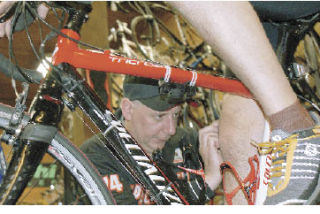May is National Bike Month and perhaps you’ve pulled your bike down from the garage rafters and decided to take a ride around the block.
Or perhaps you’ve been training for that “century” bike ride you have coming up this summer.
Whether you’re a casual rider, or advanced, you have to ask yourself one question: does your bike fit you correctly?
When my father, Al Knopik, first told me he was taking his bike in for a professional fitting, I knew that was something I had to see. I had no idea such things existed.
We headed down the hill to the Bonney Lake Bicycle Shop in Sumner.
Here we met Jim Stevenson, customer service and bicycle fit specialist for the shop.
There are three different types of fittings. One for casual riders, one for enthusiast riders and one for elite riders. And since my dad has been training for the last few years to become the next Lance Armstrong, he was going for the advanced fitting.
“I start each fitting with an assessment intake,” Stevenson said. “This helps me to understand the rider and their personal goals.”
The assessment included questions about riding style, how long the rider has been cycling, hours they bike per week and any physical issues to be aware of, such as knee replacements.
After the questions it was time for the physical assessment.
He checked my dad for flexibility, the angles of his body and had him perform a number of exercises while standing barefoot on the ground.
“Every motion that he is performing will be a motion that is experienced on the bicycle,” Stevenson explained as he watched my dad perform one-legged squats.
While performing this motion Stevenson noticed something about the way my dad’s knees were moving. He pointed out that they were collapsing inward. “This is very common among riders. Remember how that movement looks, and we’ll look for it once he’s on the bike.”
With the bike hooked into a trainer, my dad was ready to pedal. He warmed up for a bit and then it was time for more measuring of angles.
Stevenson was looking for the angles at which my dad’s knees were moving when his leg was fully extended. He found that the bike seat was too low and the angle needed to be changed. By lifting the height of the seat, that angle was corrected.
Next Stevenson had my dad pedal again while he studied the movement from the front of the bike.
“Notice anything similar about this movement?” He asked me. And it was true. My dad’s knees looked just like they had while he was performing the squat exercise.
“It is so common among riders, but often not corrected,” Stevenson said. “Poor knee alignment is a very easy way to injure yourself.”
To correct this, Stevenson added inserts into my dad’s shoes and replaced the clips on his shoes.
He then hung a plumb bob from my dad’s knees to check that the knee was in the correct position with the ground during pedal strokes.
“I would say that about 60 to 70 percent of riders that I have worked with have needed some major changes,” Stevenson said.
He told my dad to take the bike out for a ride and let him know how it felt.
Stevenson uses the Specialized program for fitting, one of five proven methods available. To become a certified bicycle fit specialist, he had to travel to the Specialized bicycle component university in Morgan Hill, Calif. While there he spent four solid days completing the Body Geometry and Product Fundamentals of Specialized and the Body Geometry Fit Course.
“The program is not about trying to fit the rider to the bike,” Stevenson said. “It’s about fitting the bike to the rider.”



